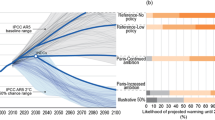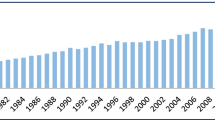Abstract
The purpose of this study is to examine the role of economic structure of European countries into testing the Environmental Kuznets Curve (EKC) hypothesis for European countries for the period 1980 to 2014. This study is inspired by the work of Lin et al. (J Clean Prod 133:712–724, 2016), which made the first effort to investigate the phenomenon looking only at African countries. The main finding of the study is that the overall economic growth is the factor with which CO2 emissions exhibit an inverted U-shaped relationship in the studied country group. On the contrary, when using their industrial share as a proxy to capture the countries’ economic structure, the EKC hypothesis is not confirmed – but a U-shaped relationship is confirmed. The industrial share decreases emissions through the development and absorption of technologies that are energy efficient and environmental friendly. The EKC hypothesis is confirmed when the aggregate GDP growth is considered, taking into account the improvement of the overall economic conditions of the countries regardless of the economic structure and role of industrialization.
Similar content being viewed by others
References
Apergis N, Ozturk I (2015) Testing environmental Kuznets curve hypothesis in Asian countries. Ecol Indic 52:16–22
Arrow K, Bolin B, Costanza R, Dasgupta P, Folke C, Holling CS et al (1996) Economic growth, carrying capacity, and the environment. Ecol Appl 6:13–15
Balsalobre-Lorente DB, Alvarez-Herranz A (2016) An approach to the effect of energy innovation on environmental Kuznets curve: an introduction to inflection point. Bull Energy Econ 4(3):224–233
Bilgili F, Kocak E, Bulut U (2016) The dynamic impact of renewable energy consumption on CO2 emissions: a revisited environmental Kuznets curve approach. Renew Sust Energ Rev 54:838–845
Boden TA, Marland G, Andres RJ (2011) Gobal, regional and national fossil fuel CO2 emissions. US Department of Energy. Carbon Dioxide Information Analysis Center
Brock W, Taylor MS (2005) Economic growth and environment: a review of theory and empirics. In: Durlauf S, Aghion P (eds) The handbook of economic growth. Elsevier, Amsterdam, pp 1749–1821
Burton E (2000) The compact city: just or just compact? A preliminary analysis. Urban Stud 37:1969–2001
Canadell JG, Raupach MR, Houghton RA (2008) Anthropogenic CO2 emissions in Africa. Biogeosciences Discussion
Capello R, Camagni R (2000) Beyond optimal city size: an evaluation of alternative urban growth patterns. Urban Stud 37:1479–1496
Carson RT (2010) The environmental Kuznets curve: seeking empirical regularity and theoretical structure. Rev Environ Econ Policy 4:3–23
Chen Y, Lin S (2015) Decomposition and allocation of energy-related carbon dioxide emission allowance over provinces of China. Nat Hazards 76(3):1893–1909
Chertow MR (2008) The IPAT Equation and its variants. J Ind Ecol 4(4):13–29
Choi I (2001) Unit root tests for panel data. J Int Money Financ 20:249–272
Choi S-W (2014) Economic growth and terrorism: domestic , international, and suicide. Oxf Econ Pap 67(1):1–25. https://doi.org/10.1093/oep/gpu036
Chow GC, Li J (2014) Environmental Kuznets curve: conclusive econometric evidence for CO2. Pac Econ Rev 19:1–17
Destek MA, Ulucak R, Dogan E (2018) Analyzing the environmental Kuznets curve for the EU countries; the role of ecological footprint. Environ Sci Pollut Res 25:29387–29396
El Montasser G, Ajmi AN, Nguyen DK (2018) Carbon emissions- income relationships with structural breaks: the case of the middle eastern and north African countries. Environ Sci Pollut Res 1:1–10
Gertler P, Shelef O, Wolfram C, Fuchs A (2013) How pro-poor growth affects the demand for energy. NBER, Cambridge Working paper series No 19092
Ghazali A, Ali G (2019) Investigation of key contributors of CO2 emissions in extended STIRPAT model for newly industrialized countries: a dynamic common correlated estimator (DCCE) approach. Energy Rep 5:242–252
Grossman GM, Krueger AB (1995) Economic growth and the environment. Q J Econ 110(2):353–377
Hao Y, Liu Y, Weng J-H, Gao Y (2016) Does the environmental Kuznets curve for coal consumption in China exist? New evidence from spatial econometric analysis. Energy 114:1214–1223
Harbaugh B, Levinson A, Wilson DM (2002) Reexamining the empirical evidence for an environmental Kuznets curve. Rev Econ Stat 84:541–551
He Y, Lin B (2019) Investigating environmental Kuznets curve from an energy intensity perspective: empirical evidence from China. J Clean Prod 234:1013–1022. https://doi.org/10.1016/j.jclepro.2019.06.121
Horii R, Ikefuji M (2014) Environment and Growth. MPRA, Munich Paper no 53624
Im KS, Pesaran MH, Shin Y (2003) Testing for unit roots in heterogeneous panels. J Econ 115:53–74
Kaika D, Zervas E (2013) The environmental Kuznets curve (EKC) theory - part B: critical issues. Energy Policy 62:1403–1411
Kao C (1999) Spurious regression and residual-based tests for cointegration in panel data when the cross-section and time series dimensions are comparable. J Econ 90:1–44
Kuznets S (1955) Economic growth and income inequality. Am Econ Rev 45:1–18
Lee C, Chui Y, Sun C (2010) The environmental Kuznets curve hypothesis for water pollution: do regions matter? Energy Policy 38:12–23
Liddle B (2012) The importance of energy quality in energy intensive manufacturing: evidence from panel cointegration and panel FMOLS. Energy Econ 34:1819–1825
Lin B, Omoju OE, Nwakeze NM, Okonkwo JU (2016) Is the environmental Kuznets curve hypothesis a sound basis for environmental policy in Africa? J Clean Prod 133:712–724
Lin S, Wang S, Marinova D, Zhao D, Hong J (2017) Impacts of urbanization and real economic development on CO2 emissions in non-high income countries: empirical research based on the extended STIRPAT model. J Clean Prod 166:952–966
Martinez-Zarzoso I (2008) The impact of urbanization on CO2 emissions evidence from developing countries. Nota Di Lavoro 50, Fondazione Eni Enrico Mattei, Milan
Ozcan B, Ozturk I (2019) In: Ozcan B, Ozturk I (eds) Environmental Kuznets Curve (EKC). Elsevier, Amsterdam
Pachauri S (2004) An analysis of cross-sectional variations in total household energy requirements in India using micro survey data. Energy Policy 32:1723–1735
Pachauri S, Jiang L (2008) The household energy transition in India and China. Energy Policy 36:4022–4035
Paudel KP, Zapata H, Susanto D (2005) An empirical test of environmental Kuznets curve for water pollution. Environ Resour Econ 31:325–348
Pedroni P (2004) Panel cointegration: asymptotic and finite sample properties of pooled time series tests with an application to the PPP hypothesis. Economic Theory 20:597–625
Perman R, Stern DI (2003) Evidence from panel unit root and cointegration tests that the environmental Kuznets curve does not exist. Aust J Agric Resour Econ 47:325–347
Philips PC, Hansen BE (1990) Statistical inference in instrumental variables regression with I(1) processes. Rev Econ Stud 57:99–125
Poumanyvong P, Kaneko S (2010) Does urbanization lead to less energy use and lower CO2 emissions? A cross-country analysis. Ecol Econ:434–444
Roy M, Basu S, Pal P (2017) Examining the driving forces in moving toward a low carbon society: an extended STIRPAT analysis for a fast growing vast economy. Clean Techn Environ Policy 19(9):2265–2276
Sadorsky P (2014) The effect of urbanisation on CO2 emissions in emerging economies. Energy Econ 41:147–153
Shafik N (1994) Economic development and environmental quality: an econometric analysis. Oxf Econ Pap 46:757–773
Shahbaz M, Solarin SA, Sbia R, Bibi S (2015) Does energy intensity contribute to CO2 emissions? A trivariate analysis in selected African countries. Ecol Indic 50:215–224
Shahbaz M, Solarin SA, Hammoudeh S, Shahzad S (2017) Bounds testing approach to analyzing the environment Kuznets curve hypothesis with structural beaks: the role of biomass energy consumption in the United States. Energy Econ:548–565
Sinha A, Shahbaz M, Balsalobre D (2019) Chapter 7 - data selection and environmental Kuznets curve models - environmental Kuznets curve models, data choice, data sources, missing data, balanced and unbalanced panels. In: Özcan B, Öztürk I (eds) Environmental Kuznets curve (EKC). Academic, Cambridge, pp 65–83. https://doi.org/10.1016/B978-0-12-816797-7.00007-2
Song ML, Guo X, Wu KY, Wang GX (2015) Driving effect analysis of energy consumption carbon emissions in the Yangtze River Delta region. J Clean Prod 103:620–628
Stern DI (2004) The rise and fall of the environmental Kuznets curve. World Dev 32:1419–1439
Stern DI, Common MS (2001) Is there an environmental Kuznets curve for sulphur? J Environ Econ Environ Manag 41:162–178
Stokey N (1998) Are there limits to growth? Int Econ Rev:1–31
Thompson A (2014) Environmental Kuznets curve for water pollution: the case of border countries. Mod Econ 5:66–69
Tursun H, Li ZY, Liu R, Li Y, Wang XH (2015) Contribution weight of engineering technology on pollutant emission reduction based on IPAT and LMDI methods. Clean Techn Environ Policy 17(1):225–235
Wachernagel M, Rees W (1996) Our ecological footprint: reducing human impact on earth. New Society Problishers, Gabriola The New Catalyst Bioregional Series
Wang YN, Zhao T (2015) Impacts of energy-related CO2 emissions: evidence from under developed, developing and highly developed regions in China. Ecol Indic 50:186–195
Wang P, Wu W, Zhu B, Wei Y (2013) Examining the impact factors of energy-related CO2 emissions using the STIRPAT model in Guangdong Province, China. Appl Energy 106:65–71
Wang Y, Han R, Kubota J (2016) Is there an environmental Kuznets curve for SO2 emissions? A semi-parametric panel data analysis for China. Renew Sust Energ Rev 54:1182–1188
Wang C, Wang F, Zhang X, Yang Y, Su Y, Ye Y, Zhang H (2017) Examining the driving factors of energy related carbon emissions using the extended STIRPAT model based on IPAT identity in Xinjiang. Renew Sust Energ Rev 67:51–61
You J (2011) China's energy consumption and sustainable development: comparative evidence from GDP and genuine savings. Renew Sust Energ Rev 15:2984–2989
Zafar F, Anwar S, Hussain Z, Ahmad N (2013) Impact of trade liberalisation and corruption on environmental degradation in Pakistan. J Financ Econ 1:2984–2989
Author information
Authors and Affiliations
Corresponding author
Additional information
Responsible editor: Philippe Garrigues
Publisher’s note
Springer Nature remains neutral with regard to jurisdictional claims in published maps and institutional affiliations.
Rights and permissions
About this article
Cite this article
Dogan, E., Inglesi-Lotz, R. The impact of economic structure to the environmental Kuznets curve (EKC) hypothesis: evidence from European countries. Environ Sci Pollut Res 27, 12717–12724 (2020). https://doi.org/10.1007/s11356-020-07878-2
Received:
Accepted:
Published:
Issue Date:
DOI: https://doi.org/10.1007/s11356-020-07878-2




